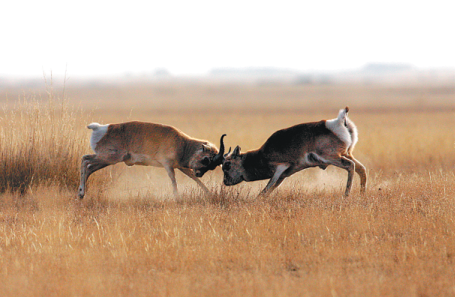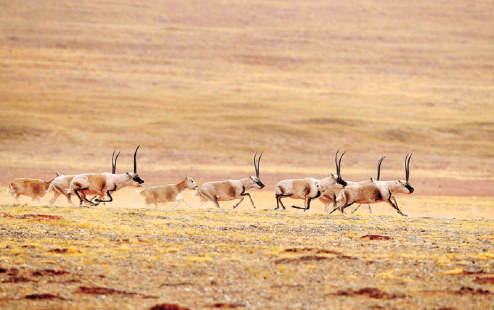
Two male Przewalski's gazelles fight on grasslands in Gangcha county, Qinghai province. GE YUXIU/FOR CHINA DAILY
Peng Yu's early days of working at the Mengda National Natural Reserve left a lot of bitter memories.
Fifteen years ago, it was no surprise that Peng's daily routine of monitoring and caring for various species saw her wear out at least three pairs of shoes a year, especially as she sometimes lost her way after darkness enveloped the 17,290-hectare reserve.
Recently, though, the 41-year-old's job has become much easier because China is moving ahead with construction of a national biodiversity network that features many smart devices and facilities.
Tramping across the reserve's rugged terrain at an average altitude of more than 2,800 meters in Xunhua Salar autonomous county, Qinghai province, is never easy.
Peng's work can take her anywhere, through thick bushes and tall plants, and in a reserve as big as Mengda, it is easy for staff to lose their bearings.
In May 2008, for example, Peng's team failed to find its way back to their office until almost 9 pm, and one of her colleagues almost stepped off the edge of a cliff because of the low light and the dense greenery.
The daily routine became even more challenging when the plants became infected with pests. Some of her colleagues had to walk around the reserve carrying 20-kilogram sprayers containing pesticide. Her office illustrated the Spartan conditions. "I had almost nothing but a desk," Peng recalled.

A close-up of a male Przewalski's gazelle in Haiyan county, Qinghai. GE YUXIU/FOR CHINA DAILY
Improved conditions
Now, working conditions in the reserve are changing dramatically as China bolsters efforts to improve conservation of biodiversity.
Although Peng and her colleagues still have to patrol the reserve to conduct routine observations and surveys, the frequency of the treks has fallen as a result of the use of smart equipment.
In addition to three unmanned aerial vehicles, used especially for monitoring, the protected area now has 46 sets of infrared cameras, according to the management office.
The rangers are also spared the effort of carrying the sprayers because drones are now used to spray the reserve with pesticide.

A herd of Tibetan antelopes runs across grassland in Hoh Xil in Qinghai. GE YUXIU/FOR CHINA DAILY
Peng has also seen the number of team members rise as the country attaches increasing importance to the conservation of biodiversity. When she started working at the reserve in 2006, only five technicians were employed to oversee species protection efforts. Now, the number has risen to 18.
The reserve is just a microcosm of the increasingly stronger ecosystem monitoring capabilities in Qinghai and across the country as a whole.
Ren Yong, head of ecosystem protection at the Qinghai Department of Ecology and Environment, said the province has established a monitoring system that covers all the areas under its jurisdiction.
While the province uses remote sensing methods to monitor different types of ecosystems, such as the high-altitude grassy marshland and prairies, the authorities responsible for protecting the land also monitor specific species, he said.
"Generally speaking, the province has established a system that consists of both micro- and niche-targeted monitoring," Ren said, adding that the authorities often use field monitoring equipment to assess problems unearthed by remote sensing.
According to the Ministry of Ecology and Environment, 18 percent of China's land has been designated as protected areas. That has provided effective protection for 90 percent of all land ecosystems and 85 percent of key wild animal populations.

A cormorant eats a fish in the Buha River in Gangcha county, Qinghai. GE YUXIU/FOR CHINA DAILY
National network
The ministry has also been promoting construction of a national network to monitor biodiversity conservation.
At a news conference in January, Cui Shuhong, director-general of nature and eco-conservation department at the ministry, said that from 2015 to last year, the department invested 400 million yuan ($62 million) in biodiversity surveys and assessments, and the construction of a national biodiversity observation network.
Government bodies, including the National Forestry and Grassland Administration and various institutions at the Chinese Academy of Sciences, are also involved in the efforts, both in terms of conservation and by providing funds.
The work, involving more than 2,000 researchers, has provided a clear picture of the country's biodiversity situation.
Thanks to the efforts in the last five years, a preliminary monitoring network for biodiversity has already been established, Cui said. He noted that the 749 sample observation areas across the country allow the network to provide more than 700,000 pieces of data every year.
In January, Huang Runqiu, minister of ecology and environment, told the ministry's annual National Environmental Protection Conference that the system will be fully established this year.

A herd of kiangs passes through an area near the Kunlun Mountains in Qinghai. GE YUXIU/FOR CHINA DAILY
He added that the ministry will also launch demonstration programs in key areas for biodiversity protection as it strives to promote legislation to protect biodiversity.
Meanwhile, speaking on June 5 at an event held in Xining, Qinghai's provincial capital, to mark World Environment Day, Huang said China will speed up construction of a countrywide protected land system where national parks will play a dominant role.
The country will also accelerate efforts to roll out protection and restoration projects for key ecosystems and major projects for biodiversity conservation, he added.
The ongoing efforts on conservation have already paid off, as can be seen in Qinghai.
Speaking at the June 5 event, Xin Changxing, governor of Qinghai, said the number of Przewalski's gazelle in the province, a species of antelope listed as endangered, has risen from about 300 at the end of the last century to the current 2,700.
The population of Tibetan antelopes experienced even more robust growth. "From a record low of less than 20,000, the number in Qinghai alone has now reached more than 70,000," Xin said.

CHINA DAILY

